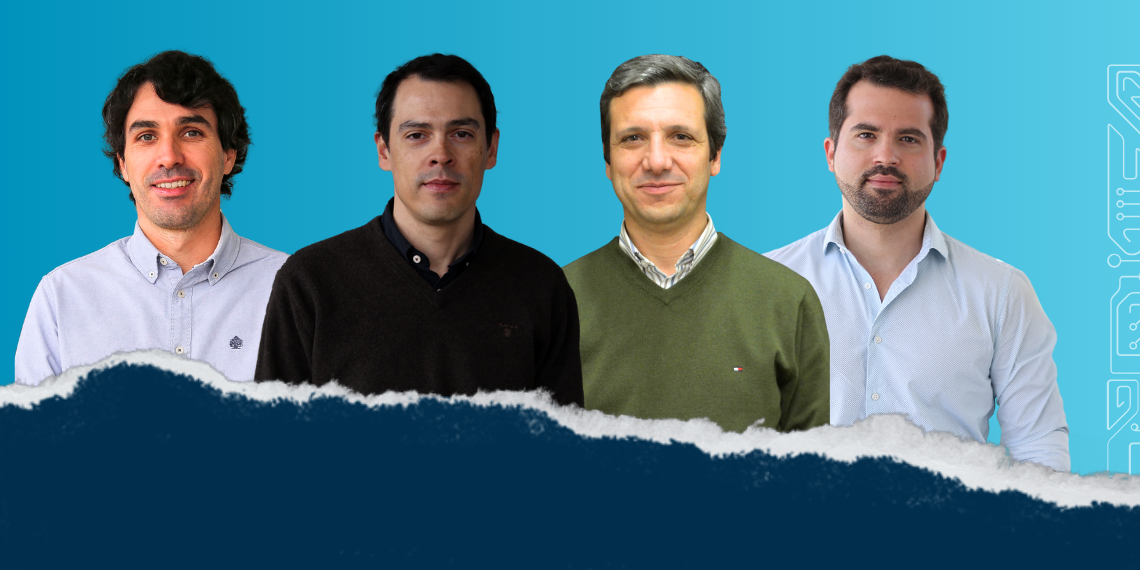We already covered what happened on April 28, 2025 in the Iberian Peninsula in the last edition of the INESCTEC Watch – focusing on power & energy systems. But it wasn’t just the power grid that “went dark” that day. Another critical infrastructure was compromised in mainland Portugal – the national communications systems which were affected and reacted differently. In this edition, we reached out to several INESC TEC experts dedicated to telecommunications research to try to understand what happened, what are the features of these systems – and how this helps explain how they behaved – and what lessons should we learn.
The fact is that the electricity supply failed across mainland Portugal for nearly 10 hours. As some were still trying to figure out whether the power outage was limited to their home or the area they happened to be in at the time and attempted to notify others about delays concerning online commitments (at least those still able to communicate) – many realised that the blackout was widespread. Those who managed to establish communications quickly began to realise that the situation covered, at least, the entire Iberian Peninsula. Others took some time to understand what was going on, because they remained without telecommunications access for several hours.
The three most talked communications systems
There were several news reports about what had happened, and even the president of ANACOM, Sandra Maximiano, acknowledged that the backup systems used by operators in the communications sector were not prepared for the blackout that occurred in Portugal.
But what exactly are the three communications systems that have been most talked about in the media? 1) The 4G/5G communications operated by mobile communications operators, 2) the TETRA system operated by SIRESP and 3) the FM communications system used by radio broadcasting in Portugal.
 According to Manuel Ricardo, director at INESC TEC and professor at the Faculty of Engineering of the University of Porto (FEUP), the three types of communication systems share common features, in that the terminal – such as a mobile phones or other devices – communicates via a radio link with a ground base station. This base station – the most visible component of which is the communications tower, often simply referred to as the “antenna” – transmits at a frequency and power level that determine the size of each cell. To cover the whole country, it is necessary to put together many of said cells. The base stations of a system – i.e., all those “antennas” – are connected to a central communications network (a kind of “control centre”) equivalent to a data centre, made up of servers and computer networks that manage the entire system and communications.
According to Manuel Ricardo, director at INESC TEC and professor at the Faculty of Engineering of the University of Porto (FEUP), the three types of communication systems share common features, in that the terminal – such as a mobile phones or other devices – communicates via a radio link with a ground base station. This base station – the most visible component of which is the communications tower, often simply referred to as the “antenna” – transmits at a frequency and power level that determine the size of each cell. To cover the whole country, it is necessary to put together many of said cells. The base stations of a system – i.e., all those “antennas” – are connected to a central communications network (a kind of “control centre”) equivalent to a data centre, made up of servers and computer networks that manage the entire system and communications.
“The central network of each of these systems is, by definition, located in one or two sites designed to withstand rare and severe events, containing relevant redundancies and supported by diesel energy generators,” explained Manuel Ricardo, also adding that these “have the typical problems of well-designed data centres”. In the case of April 28, 2025, no major problems were reported. In the 4G/5G system, however, there were reports from users who lost roaming while abroad, as well as users who had to restart their mobile phones to reconnect to the 4G/5G network; this suggests that there were likely issues with system restart or service and database migration, along with the restoration of backups.
However, despite showing similar aspects, the terminals of these three systems also have differentiating elements. Let’s explore each one of them.
“Concerning 5G mobile phones, what happens is that the 5G terminal receives and transmits information at high rates, with high processing capacity, and colour display”, as explained by Manuel Ricardo. In other words, we can say that it is a terminal that sends and receives large amounts of data – videos, calls, emails, etc. -, with a powerful processor and a colour display. An average consumption under moderate data use translates into about 1W, which means that it has an autonomy of about 20h, including seven hours of active display time.
Regarding the TETRA system operated by SIRESP, a portable terminal (walkie-talkie) is typically used for group communications (e.g., between police officers, firefighters, and others), spending most of the time receiving short voice messages and transmitting occasionally, via a push-to-talk technique. This translates into an average consumption of about 2 W which, “considering the batteries that power it, gives it an autonomy of more than 12 hours, and the terminals placed in vehicles have greater autonomy”, as explained by the researcher.
Regarding the small, battery-powered FM receiver (the “transistor”), it only receives information; it does not send. What happens in this case is that the received signal is demodulated and sent to a small speaker. “It has a consumption of 100-300 mW and, working with two batteries, it has an autonomy of up to 50 hours in continuous operation”, as explained by Manuel Ricardo.
Therefore, the terminals of these three systems can have autonomies that, in continuous operation, range from 7 to 50 hours.
Going back to the elements of each of these systems. First, “in the case of FM communications, the base station of the communication system operates between 87.5 and 108 MHz and transmits with power ranging from 10 to 50 kW on the main transmitters, which allows it to create cells with radii of around several tens of kilometres,” explained the researcher. Let’s focus on the case of Portuguese public radio stations. Antena 1, for example, has about 40 (re)transmitters scattered throughout the country. The FM system is a mature system, and the main transmitters are equipped with generators that start operating if and when necessary, that is, even at times when there are power failures, such as the one on April 28.
 The TETRA/SIRESP base station, on the other hand, operates in the 400 MHz band and has a transmission power of about 25 W. “SIRESP covers the country with 550 base stations, distributed throughout mainland Portugal, the Azores and Madeira”, stated Rui Campos, a senior researcher at INESC TEC and a professor at FEUP. These stations are typically protected by Uninterruptible Power Supply – UPS, which are commonly referred to as batteries. However, there are about two dozen mobile diesel generators that are positioned in strategic areas of the country and can be mobilised wherever necessary.
The TETRA/SIRESP base station, on the other hand, operates in the 400 MHz band and has a transmission power of about 25 W. “SIRESP covers the country with 550 base stations, distributed throughout mainland Portugal, the Azores and Madeira”, stated Rui Campos, a senior researcher at INESC TEC and a professor at FEUP. These stations are typically protected by Uninterruptible Power Supply – UPS, which are commonly referred to as batteries. However, there are about two dozen mobile diesel generators that are positioned in strategic areas of the country and can be mobilised wherever necessary.
A 4G/5G base station operates in the 3.5 GHz band with transmission power of up to 40 W, although this power depends on the desired size of the cell it defines, due to strict requirements for nationwide coverage at 100 Mbit/s, as explained by INESC TEC experts. A 4G/5G telecommunications operator may need up to 5,000 base stations to cover the national territory. Rui Campos explained that “according to ANACOM’s report for the fourth quarter of 2024, there are 13,089 5G base stations in Portugal, among the four operators that have a license from the regulator to operate (DIGI, MEO, NOS and Vodafone).” These stations are protected by batteries with an autonomy between two and eight hours, with diesel generator sets and mobile power generators supporting cells considered critical.
The behaviour of communications systems during the blackout
Based on the analysis of the characteristics of each system, what distinguishes and separates them, the researchers pointed out that the resilience of the systems – in the specific case of April 28 – is directly linked to the duration of the blackout, the number of cells in each communication system, and the ability to deploy generator units once the batteries associated with the base stations are depleted.
“The FM system, with few cells and power generators in the main cells, had no apparent failures”, explained Manuel Ricardo.
The SIRESP system, with an installed capacity of mobile generators distributed throughout the country, struggled to deal with all the failures in the base stations whose backup batteries were exhausted.
What about 4G/5G telecommunications operators? Unable to access all sites, these operators reverted the system to the use of 2G and 4G technologies, consuming less energy and defining larger cells, allowing to reduce the number of cells to be rescued. “This strategy made it possible to ensure the coverage of the national territory, especially for voice and SMS services, although with a reduction in traffic transport capacity (voice and data). From the users’ point of view, this translated into the difficulty or impossibility of making calls or sending messages, even when the terminals detected a 2G/4G signal,” mentioned Rui Campos.
 Filipe Ribeiro, researcher at INESC TEC and coordinator of the telecommunications and multimedia area, also explained that it is necessary to mention that the increasing replacement of copper connections by fibre optic networks in homes has relevant implications from the point of view of energy resilience. “Unlike copper infrastructures, which in many cases carried enough energy to keep the terminal (e.g., old analogue telephone) operational during a local blackout, fibre optic-based systems require that all terminal equipment (ONTs, routers, etc.) be powered locally by electricity”, as he explained. Thus, a power supply failure makes any type of communication via this route unfeasible, even if the telecommunications operator’s infrastructure is operational. “Along with this technological evolution, the almost total elimination of public telephone booths has significantly increased the dependence on the domestic and mobile networks, which, as we have seen, depend on electricity in all its components,” he added. According to the researcher, these structural changes reinforce the need to rethink the resilience of communication networks, not only at the level of the central infrastructure, but also in their ability to remain operational to end users.
Filipe Ribeiro, researcher at INESC TEC and coordinator of the telecommunications and multimedia area, also explained that it is necessary to mention that the increasing replacement of copper connections by fibre optic networks in homes has relevant implications from the point of view of energy resilience. “Unlike copper infrastructures, which in many cases carried enough energy to keep the terminal (e.g., old analogue telephone) operational during a local blackout, fibre optic-based systems require that all terminal equipment (ONTs, routers, etc.) be powered locally by electricity”, as he explained. Thus, a power supply failure makes any type of communication via this route unfeasible, even if the telecommunications operator’s infrastructure is operational. “Along with this technological evolution, the almost total elimination of public telephone booths has significantly increased the dependence on the domestic and mobile networks, which, as we have seen, depend on electricity in all its components,” he added. According to the researcher, these structural changes reinforce the need to rethink the resilience of communication networks, not only at the level of the central infrastructure, but also in their ability to remain operational to end users.
How can we ensure a national communications system that can serve the government, emergency/civil protection services and the population in exceptional situations?
The FM system, broadcast-based and unidirectional, could bring something valuable to the table, and should be used to disseminate relevant information, according to the researchers.
“In emergency situations like the one experienced on April 28, smartphones themselves can play a crucial role as FM radio receivers. Although many recent models no longer support this technology, the event highlighted their relevance as a means of disseminating information in real time. From a legislative point of view at European level, it may be justified to consider measures that impose the obligation to support FM reception on all smartphones. Such a measure would ensure that, in times of crisis, the population would continue to have access to a fast, reliable, and widely accessible channel for receiving emergency communications, using a device that is within reach of most citizens,” explained Rui Campos
 But what is the reason for the disappearance of FM technology support in mobile phones? According to Luís Pessoa, also a senior researcher at INESC TEC and a professor at FEUP, there are several technical and commercial reasons. “One of them is related to the need for a dedicated antenna to receive the FM signal,” he explained. “A solution usually used by manufacturers is using the wires of the headphones (connected via 3.5 mm plug) to perform as an antenna. However, the traditional 3.5 mm input has also been eliminated from newer models to free up internal space for other features, like higher capacity batteries or improvements in water resistance. Although it is technically possible to integrate an FM antenna directly into the device, this approach would increase design complexity and require additional space, which impacts the ultra-compact designs of modern smartphones,” he added.
But what is the reason for the disappearance of FM technology support in mobile phones? According to Luís Pessoa, also a senior researcher at INESC TEC and a professor at FEUP, there are several technical and commercial reasons. “One of them is related to the need for a dedicated antenna to receive the FM signal,” he explained. “A solution usually used by manufacturers is using the wires of the headphones (connected via 3.5 mm plug) to perform as an antenna. However, the traditional 3.5 mm input has also been eliminated from newer models to free up internal space for other features, like higher capacity batteries or improvements in water resistance. Although it is technically possible to integrate an FM antenna directly into the device, this approach would increase design complexity and require additional space, which impacts the ultra-compact designs of modern smartphones,” he added.
The decision to abandon FM in mobile phones also has a strategic and commercial aspect. “For content providers, it is more cost-effective to stream radio access, which also promotes mobile data consumption. There are, however, exceptions: in Mexico, for example, the legislation obliges all marketed mobile phones to support FM reception, if the chip allows it. In countries like the United States or Brazil, there are only recommendations or incentives from the competent entities. Studying the experience of these countries may reveal positive or negative impacts associated with such measures”, explained Luís Pessoa.
According to Manuel Ricardo, 4G/5G operators – in liaison with ANACOM – should define a national network of large (macro) low-data-rate communication cells that cooperatively and redundantly cover the entire country, overlapping with the smaller cells, which will inevitably still be needed. “This network of macro-cells should be particularly well protected, and, from this point of view, the FM system can be used as a reference”, explained the researcher. To make this possible, it may be necessary to rely on national roaming, through an agreement between national telecom operators – like what already happens today with emergency calls, where any user can make an emergency call even without credit or a connection to their own operator’s base station.
“SIRESP should move towards a central network based on the 5G service architecture and integrate the Mission-Critical solutions defined by the 3GPP 4G/5G standards, with two main objectives: to also use the cells and radio access networks of 4G/5G telecommunications operators, including the proposed national macro-cell network, and to use multimedia services,” explained Manuel Ricardo. For readers less familiar with telecommunications jargon, the researcher explained that this is equivalent to WhatsApp group communications – including voice and video – but in a professional version (usable, for instance, by users with their hands busy), which is reliable, secure, and managed by the relevant authorities. “This solution based on 4G/5G technology is already used, for example, in FirstNet, the emergency communications network established by the US Congress in 2012, following the communication failures identified during the attacks of September 11, 2001. FirstNet was designed using a dedicated network core infrastructure (separate from commercial networks), ensuring that emergency and public safety traffic is handled in a distinct and secure manner. However, it makes use of commercial base stations – whose capacity has been reinforced with a thousand new sites to improve coverage in rural and remote areas,” explained Rui Campos
Filipe Ribeiro also added that, in addition to the advanced technological solutions already mentioned, it is also important to consider more classic approaches to emergency communication that have shown proven effectiveness in several European countries. “Sound broadcasting through loudspeakers installed in urban and rural areas, for example, continues to be used in Germany, the Netherlands, and the United Kingdom as a means of quickly alerting the population in the event of a disaster,” he explained. Additionally, considering that fibre optic-based communications systems require local power for operation, it is crucial to think of solutions that mitigate this vulnerability. “One practical possibility would be the inclusion of small UPS units in the service packages provided by operators, These UPS units would allow essential equipment in households, like ONTs, Wi-Fi routers, and their terminals (e.g., smartphones), to remain operational for several hours in the event of a power failure,” added Filipe Ribeiro. This would ensure, for example, continuous access to the Internet by radio applications or to local communication networks in critical situations, as well as the possibility of making calls through the optical or coaxial cable using the telecommunications operators’ Voice over IP (VoIP) technology.
Another possibility that any home consumer may consider is to purchase a UPS to power their essential equipment themselves. “However, it is crucial that telecommunications operators also ensure the operational continuity of their network infrastructure, ensuring adequate backup systems at the access, aggregation and core nodes,” as Luís Pessoa explained. From the information available, customers of Vodafone and Digi faced widespread service failures which suggests that multiple components of their infrastructure were affected. The combination of efforts between consumers and operators can contribute to a greater robustness of communications in emergencies.
Thus, by reconciling the energy management of mobile cells with that of the fixed network, it may be possible to extend the autonomy of communications at the national level, ensuring greater resilience in the face of the widespread failure in the supply of electricity. In addition, in case of a national emergency, it would be important to have automatic referral to a web page (landing page) with updated official information as well as the possibility of broadcasting national radio and TV. “A solution of this type, simple and scalable, can be decisive to ensure that the population remains correctly informed and with some communication capacity during longer periods, with the advantage of not overloading the 4G/5G mobile network”, concluded researcher Filipe Ribeiro.
Now, we realise that despite the failures recorded in the communications systems during the blackout of April 28, there are lessons to be learned and measures that can be implemented so that these events do not happen again. The models proposed by INESC TEC researchers “can and should serve as a basis for the evolution of the emergency communications network in Portugal”.



 News, current topics, curiosities and so much more about INESC TEC and its community!
News, current topics, curiosities and so much more about INESC TEC and its community!